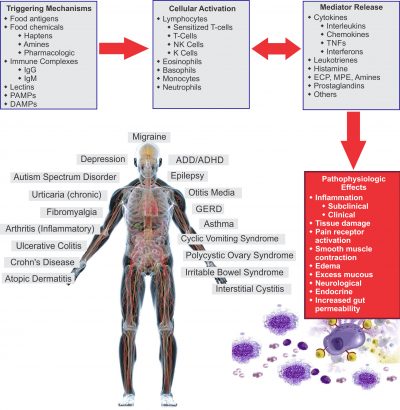Food Sensitivity Testing
Is HEALTHY food making you SICK?
Take the quiz to find out!

Do you suffer from bloating, digestive issues, fatigue, stubborn body fat, headaches, body pains, skin problems, allergies, autoimmune disease, or other chronic health concerns?
Food sensitivities play a huge role in these types of conditions. Why? Because when you ingest a food or substance that causes a reaction, your immune cells release a variety of messengers called “mediators”, which put the body on red alert.
Unfortunately, these same mediators cause inflammation, hormone changes, tissue damage, and a variety of other physiological changes that lead to chronic symptoms. Continuous exposure to reactive food elements will lead to inflammatory conditions, chronic pain, hormone imbalances, abdominal distress, disease, and other serious health problems.
How can you avoid this?
IDENTIFY YOUR UNIQUE TRIGGERS. The best way to do this is through MRT/LEAP (the most reliable food sensitivity test on the market).
By doing this, you calm the immune response and reduce the inflammation in your system, allowing your intestinal tract and the rest of your body to heal. Clients typically notice a drastic reduction in symptoms within just 7-10 days.
After a short time of avoiding reactive foods, your reactivity diminishes and foods can be re-introduced.
Many clients regain tolerance to their reactive foods.
Here are some common Questions and Answers
to get you started:
What is MRT?
MRT stands for Mediator Release Test. It is a blood test which measures your immune reaction to the most common 170 foods and chemicals. It is currently the most accurate test for identifying food sensitivities. When the immune system reacts to something you ingest, your white blood cells release chemical messengers called mediators. These mediators enable inflammation, tissue damage, vascular changes and other biochemical effects, which eventually lead to symptoms like pain, fatigue, and digestive distress. MRT measures the release of these mediators that directly cause your symptoms. It has shown the highest accuracy and reliability in scientific research.
What is LEAP?
LEAP stands for Lifestyle Eating and Performance. It is a tested diet protocol which is designed to identify and eliminate reactive foods from you diet, based on your MRT results. If done correctly, it will also identify other foods and chemicals (not identifiable via MRT) that may be causing you issues. The protocol involves removal of your reactive foods for a short period of time, which will allow your system to heal. Foods are then reintroduced to reassess tolerance. It is the best way to get full healing and benefit from your investment.
Do I need to be on an “eating everything diet” before the test?
No, you don’t need to be on any kind of diet (or lack of diet) before the test. It measures how certain foods and chemicals affect your immune system, regardless of whether or not you regularly consume them. That being said, your immune system can lose “memory” if you have not consumed a certain food for longer than 6 months. In this case, you may want to consume that food before taking the test. (Caution: DO NOT expose yourself to a food you have a known allergy to)
Can MRT identify food allergies?
No. A true food allergy, or type 1 hypersenstivity, involves IgE antibodies and occurs in only about 1-2% of the population. MRT tests for non-IgE mediated food sensitivity reactions, which are much more common. The LEAP diet protocol, however, WILL help to identify ALL types of reactions, including allergies.
Does MRT test for Celiac Disease?
No. Celiac Disease is a different immune pathway and requires tTG IgA and/or EMA testing. However MRT will identify a food sensitivity reaction (mediator release) to the gluten grains. To properly rule out Celiac Disease, testing can be obtained through your doctor (Canada and USA) or you can purchase online (USA only). Note that you must be consuming the gluten equivalent of 2 crackers or 1/2 a piece of bread daily for at least 8 weeks before taking the test.
What symptoms and conditions may indicate a need for testing?
The most common symptoms of a reactive immune system include: migraines and headaches, bloating and digestive issues, frequent diarrhea or constipation, heartburn and GERD, fibromyalgia, arthritis, joint and muscle pains, weight gain, chronic fatigue, chronic sinus congestion, insomnia, skin eruptions, eczema, autism, brain fog, ADHD, and autoimmune disease. Because the release of mediators can affect almost every organ and system in your body, the possible side effects are endless. If you think you may be reacting to your diet, most likely you are.
What's the cost and who can get tested?
This specialised and patented blood test is available in the USA and Canada. (Must be 6 months or older). It is essential to your success to have proper assessment and implementation if you wish to get the most from your investment. This test is a powerful and informative TOOL, but like all information and tools, is only effective if implemented correctly. I use your results as a gateway to your healing process, to properly LISTEN to your body on a cellular level and remove what is causing inflammation. This allows for the digestive tract and immune system to calm and re-calibrate, which then sets the crucial foundation upon which to heal fully.
Pricing will vary depending on the level of support you choose. Options include:
Full Assessment, MRT Testing and Protocol
Professional Implementation and Follow Up
Complete Healing Plan with Customised Recipes
Signature Solution (8 Week Full Spectrum Healing Program)
How does MRT differ from other intolerance tests?
Food allergies are IgE mediated and therefore identified using tests which measure IgE levels in the blood (such as the IgE ELISA and RAST tests), histamine levels (BHRT test), or by provoking a direct reaction on the skin (skin prick and scratch tests). These reactions are classified as type 1 hypersensitivities and are relatively rare. They take a specific pathway involving IgE antibodies.
Food sensitivities are classified as type 3 and 4 hypersensitivities, and occur in most of the population! The tests mentioned above will not detect these reactions. IgG antibody testing has become extremely popular, but the scientific literature concludes that these antibodies are in fact markers of exposure, not intolerance. The best way to test for food sensitivities is to test for the end result: mediator release. There are 2 tests that perform this function: ALCAT and MRT. MRT is performed using newer technology and has been shown to be more accurate and reliable than ALCAT.
Why not just do an elimination, GAPS, or FODMAP diet?
An elimination diet is a great place to start, but typically this will only single out the most common food allergens. You could be reacting to multiple foods and chemicals, all of which would likely not be identified in a typical elimination diet. GAPS and FODMAP only remove certain elements from your diet as well, which may or may not be the foods you are actually reacting to. The LEAP program is designed to catch ALL food sensitivities and intolerances, even those which do not elicit an immune response and thus would not be identified with MRT (such as intolerances caused by poor digestion, localized irritation, etc).
Can I get an insurance receipt for the test and counselling services?
Yes. We are registered under ANQ (the Association of Naturotherapists of Quebec), which is covered by most private health plans. Please see more details about coverage here https://meganpennington.com/insurance/
Get Free Tips to Create the Body
& Life You Want!
[mailmunch-form id=”770798″]
MRT Testing and Full Healing Plan
Uncover the root cause and get the support you need
Get Free Tips to Create the Body
& Life You Want!
[mailmunch-form id=”770798″]


